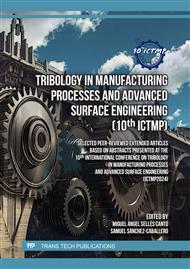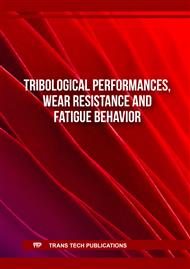[1]
A.I. Munoz, N. Espallargas, S. Mischler, Tribocorrosion, Springer Briefs in Applied Sciences and Technology. Springer, Cham, Switzerland, 2020.
Google Scholar
[2]
S. Mischler, A.I. Munoz, Tribocorrosion, in: K. Wandelt (Ed.) Encyclopedia of Interfacial Chemistry, Elsevier, Oxford, 2018, pp.504-514.
DOI: 10.1016/b978-0-12-409547-2.13424-9
Google Scholar
[3]
A. Zaffora, F.D. Franco, M. Santamaría, Corrosion of stainless steel in food and pharmaceutical industry, Current Opinion in Electrochemistry, 29 (2021) 1-7.
DOI: 10.1016/j.coelec.2021.100760
Google Scholar
[4]
A.O. Okoani, A. Nand, M. Ramezani, Tribo-electrochemical investigation of 60NiTi alloy in saline solution, Journal of Alloys and Metallurgical Systems, 6 (2024) 100074.
DOI: 10.1016/j.jalmes.2024.100074
Google Scholar
[5]
H. Chen, Z. Zhang, X.H. Hao, B.X. Huang, X.C. Zhao, C.C. Hu, Microstructure and tribocorrosion properties of NiTi/AlNi2Ti ternary intermetallic alloy, Vacuum, 184(2021)1-12.
DOI: 10.1016/j.vacuum.2020.109928
Google Scholar
[6]
S. Varmaziar, M. Atapour, Y.S. Hedberg, Corrosion and metal release characterization of stainless steel 316L weld zones in whey protein solution, npj Materials Degradation, 6 (2022) 1-9.
DOI: 10.1038/s41529-022-00231-7
Google Scholar
[7]
Z. Du, Z. Hu, Y. Feng, F. Mo, The effect of powder composition on the microstructure and corrosion resistance of laser cladding 60NiTi alloy coatings on SS 316L, Metals,11(2021)1-16.
DOI: 10.3390/met11071104
Google Scholar
[8]
A. Dalmau, C. Richard, A. Igual – Muñoz, Degradation mechanisms in martensitic stainless steels: Wear, corrosion and tribocorrosion appraisal, Tribology International, 121 (2018) 167-179.
DOI: 10.1016/j.triboint.2018.01.036
Google Scholar
[9]
M. Atapour, I. Odnevall Wallinder, Y.S. Hedberg, Stainless steel in simulated milk and whey protein solutions - Influence of grade on corrosion and metal release, Electrochimica Acta, 331 (2020).
DOI: 10.1016/j.electacta.2019.135428
Google Scholar
[10]
M.K. Stanford, Thermophysical properties of 60-nitinol for mechanical component applications, NASA Technical Report. NASA/TM—2012-216056, (2012).
Google Scholar
[11]
A.C. Vieira, L.A. Rocha, N. Papageorgiou, S. Mischler, Mechanical and electrochemical deterioration mechanisms in the tribocorrosion of Al alloys in NaCl and in NaNO3 solutions, Corros. Sci., 54 (2012) 26-35.
DOI: 10.1016/j.corsci.2011.08.041
Google Scholar
[12]
S. Meddah, H. Chadli, M. Bourebia, A. Montagne, A. Iost, M. Labaiz, A. Taleb, Dry sliding wear performance of an annealed TiNi alloy with different nickel contents, Materials Research Express, 7 (2020) 1-10.
DOI: 10.1088/2053-1591/ab5dea
Google Scholar
[13]
M. Elahinia, N. Shayesteh Moghaddam, M. Taheri Andani, A. Amerinatanzi, B.A. Bimber, R.F. Hamilton, Fabrication of NiTi through additive manufacturing: A review, Prog. Mater Sci., 83 (2016) 630-663.
DOI: 10.1016/j.pmatsci.2016.08.001
Google Scholar
[14]
C. DellaCorte, NiTi alloys for tribological applications: The effects of serendipity on research and development., Annual Postdoctoral Research and Career Symposium, October 6th. NASA/ GRC-E-DAA-TN34568, Argonne IL., 2016.
Google Scholar
[15]
S.V. Pepper, C. DellaCorte, R.D. Noebe, D.R. Hull, G. Glennon, Nitinol 60 as a material for spacecraft triboelements, 13th European Space Mechanisms and Tribology Symposium - ESMATS 13 Conference, Vienna, Austria, 2009.
Google Scholar
[16]
K. Khanlari, M. Ramezani, P. Kelly, P. Cao, T. Neitzert, Reciprocating sliding wear behavior of 60NiTi as compared to 440C steel under lubricated and unlubricated conditions, Tribology Transactions, 61 (2018) 991-1002.
DOI: 10.1080/10402004.2018.1460434
Google Scholar
[17]
T. Kosec, P. Močnik, A. Legat, The tribocorrosion behaviour of NiTi alloy, Appl. Surf. Sci., 288 (2014) 727-735.
DOI: 10.1016/j.apsusc.2013.10.116
Google Scholar
[18]
C. Yan, Q. Zeng, Y. Xu, W. He, Microstructure, phase and tribocorrosion behavior of 60NiTi alloy, Appl. Surf. Sci., 498 (2019) 1-10.
DOI: 10.1016/j.apsusc.2019.143838
Google Scholar
[19]
A.O. Okoani, A. Nand, M. Ramezani, Corrosion and wear interplay: Tribo-electrochemical evaluation of NiTiNOL60 alloy in sulfuric acid, Results in Materials, 21 (2024) 1-11.
DOI: 10.1016/j.rinma.2023.100523
Google Scholar
[20]
J.P. Celis, P. Ponthiaux, F. Wenger, Tribo-corrosion of materials: Interplay between chemical, electrochemical, and mechanical reactivity of surfaces, Wear, 261 (2006) 939-946.
DOI: 10.1016/j.wear.2006.03.027
Google Scholar
[21]
M.K. Stanford, Hot isostatic pressing of 60-Nitinol, NASA Technical Report. NASA/TM-2015-218884, (2015).
Google Scholar
[22]
A.O. Okoani, A. Nand, M. Ramezani, Tribocorrosion behaviour of NiTiNOL60 alloy in an alkaline environment, Results in Engineering, 19 (2023) 1-11.
DOI: 10.1016/j.rineng.2023.101305
Google Scholar
[23]
ASTM G3-14, Standard practice for conventions applicable to electrochemical measurements in corrosion testing, American Society for Testing and Materials. Book of standards, vol. 03.02. Developed by subcommittee G01.11, (2019) 1-9.
DOI: 10.1520/g0003
Google Scholar
[24]
ASTM G119-09, Standard guide for determining synergism between wear and corrosion, American Society for Testing and Materials. Book of standards, vol. 03.02. Developed by subcommittee G02.40, (2021) 1-6.
Google Scholar
[25]
ASTM G133-22, Standard test method for linearly reciprocating ball-on-flat sliding wear, American Society for Testing and Materials. Book of standards, vol. 03.02. Developed by subcommittee G02.40, (2022) 1-10.
DOI: 10.1520/g0133-95
Google Scholar



